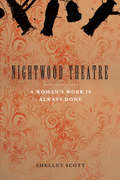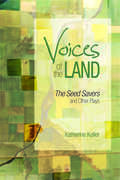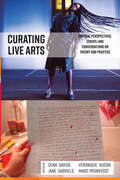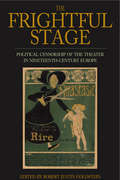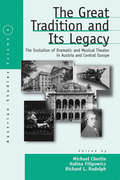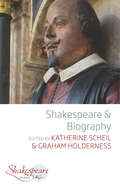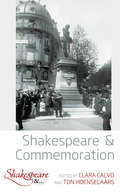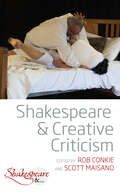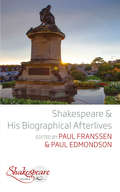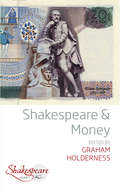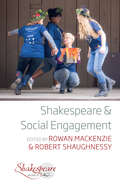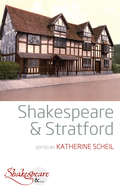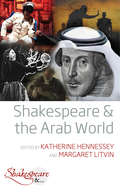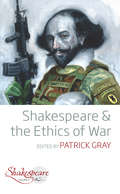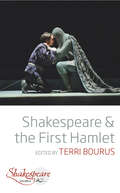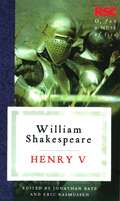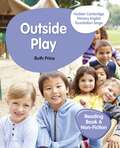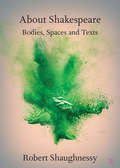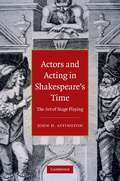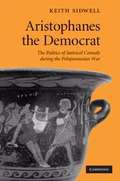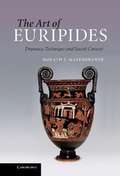- Table View
- List View
Voices of the Land: The Seed Savers and Other Plays
by Katherine KollerThe sound of the wind across a Prairie field, the smell of grass on the first day of spring, the vocalization of birds in the early morning woods, the silence of the lake at night interrupted by call of the loon – these are the shapes and sounds of the Prairie landscape. Katherine Koller invokes the Prairie setting as a central character in each of the four plays in Voices of the Land. Serving a supportive and, at other times, antagonistic role, the landscape acts upon the characters, driving and intensifying their transformation. The land and those who live in intimate terms with it are the focus of Koller’s plays. In The Seed Savers, farmers face pressure to purchase genetically modified seed; a protagonist refuses to sell untilled land for development in Cowboy Boots and a Corsage; a dying woman sees a lake as her final resting place in Abby’s Place; and in The Early Worm Club, Millie realizes a deep sense of belonging to the Alberta parkland and its birds while searching for her mate. Nature goes beyond mere setting and backdrop in these plays to effect transformation and resolution on the characters. Ranging from romantic comedy to drama and from one-act to full-length, the plays in Voices of the Land show western Canadians at the point of leaving, returning, and renewing against the backdrop of their native landscape.
Curating Live Arts: Critical Perspectives, Essays, and Conversations on Theory and Practice
by Dena Davida Marc Pronovost Véronique Hudon Jane GabrielsSituated at the crossroads of performance practice, museology, and cultural studies, live arts curation has grown in recent years to become a vibrant interdisciplinary project and a genuine global phenomenon. Curating Live Arts brings together bold and innovative essays from an international group of theorist-practitioners to pose vital questions, propose future visions, and survey the landscape of this rapidly evolving discipline. Reflecting the field’s characteristic eclecticism, the writings assembled here offer practical and insightful investigations into the curation of theatre, dance, sound art, music, and other performance forms—not only in museums, but in community, site-specific, and time-based contexts, placing it at the forefront of contemporary dialogue and discourse.
The Frightful Stage
by Robert Justin GoldsteinIn nineteenth-century Europe the ruling elites viewed the theater as a form of communication which had enormous importance. The theater provided the most significant form of mass entertainment and was the only arena aside from the church in which regular mass gatherings were possible. Therefore, drama censorship occupied a great deal of the ruling class's time and energy, with a particularly focus on proposed scripts that potentially threatened the existing political, legal, and social order. This volume provides the first comprehensive examination of nineteenth-century political theater censorship at a time, in the aftermath of the French Revolution, when the European population was becoming increasingly politically active.
The Great Tradition And Its Legacy
by Michael Cherlin Richard L. Rudolph Halina FilipowiczBoth dramatic and musical theater are part of the tradition that has made Austria - especially Vienna - and the old Habsburg lands synonymous with high culture in Central Europe. Many works, often controversial originally but now considered as classics, are still performed regularly in Vienna, Prague, Budapest, or Krakow. This volume not only offers an excellent overview of the theatrical history of the region, it is also an innovative, cross-disciplinary attempt to analyse the inner workings and dynamics of theater through a discussion of the interplay between society, the audience, and performing artists.
Shakespeare and Biography (Shakespeare & #8)
by Katherine Scheil Graham HoldernessFrom Shakespeare’s religion to his wife to his competitors in the world of early modern theatre, biographers have approached the question of the Bard’s life from numerous angles. Shakespeare & Biography offers a fresh look at the biographical questions connected with the famous playwright’s life, through essays and reflections written by prominent international scholars and biographers.
Shakespeare and Commemoration: Commemoration And Cultural Memory (Shakespeare & #2)
by Clara Calvo Ton HoenselaarsMemory and commemoration play a vital role not only in the work of Shakespeare, but also in the process that has made him a world author. As the contributors of this collection demonstrate, the phenomenon of commemoration has no single approach, as it occurs on many levels, has a long history, and is highly unpredictable in its manifestations. With an international focus and a comparative scope that explores the afterlives also of other artists, this volume shows the diverse modes of commemorative practices involving Shakespeare. Delving into these “cultures of commemoration,” it presents keen insights into the dynamics of authorship, literary fame, and afterlives in its broader socio-historical contexts.
Shakespeare and Creative Criticism (Shakespeare & #4)
by Rob Conkie Scott MaisanoWhat kinds of critical insights are made possible only or especially via creative strategies? This volume examines how creative modes of writing might facilitate or inform new ways to critically engage with Shakespeare. Creative writing, demonstrated in a series of essays, reflections, stories and scenes, operates as a vehicle for exploring and articulating critical and theoretical ideas. In doing so, Shakespeare’s enduring creative and critical appeal is newly understood and critiqued.
Shakespeare and His Biographical Afterlives (Shakespeare & #6)
by Paul Franssen & Paul EdmondsonNew Shakespeare biographies are published every year, though very little new documentary evidence has come to light. Inevitably speculative, these biographies straddle the line between fact and fiction. Shakespeare and His Biographical Afterlives explores the relationship between fiction and non-fiction within Shakespeare’s biography, across a range of subjects including feminism, class politics, wartime propaganda, children’s fiction, and religion, expanding beyond the Anglophone world to include countries such as Germany and Spain, from the seventeenth century to present day.
Shakespeare and Money (Shakespeare & #7)
by Graham HoldernessThough better known for his literary merits, Shakespeare made money, wrote about money and enabled money-making by countless others in his name. With chapters by leading scholars on the economic, financial and commercial ramifications of his work, this multifaceted volume connects the Bard to both early modern and contemporary economic conditions, revealing Shakespeare to have been a serious economist in his own right.
Shakespeare and Social Engagement (Shakespeare & #10)
by Rowan Mackenzie and Robert ShaughnessyShakespeare’s roots in applied and participatory performance practices have been recently explored within a wide variety of educational, theatrical and community settings. Shakespeare and Social Engagement explores these settings, as well as audiences who have largely been excluded from existing accounts of Shakespeare’s performance history. The contributions in this collected volume explore the complicated and vibrant encounters between a canonical cultural force and work that frequently characterizes itself as inclusive and egalitarian.
Shakespeare and Stratford (Shakespeare & #1)
by Katherine ScheilAs the site of literary pilgrimage since the eighteenth century, the home of the Royal Shakespeare Company and the topic of hundreds of imaginary portrayals, Stratford is ripe for analysis, both in terms of its factual existence and its fictional afterlife. The essays in this volume consider the various manifestations of the physical and metaphorical town on the Avon, across time, genre and place, from America to New Zealand, from children’s literature to wartime commemorations. We meet many Stratfords in this collection, real and imaginary, and the interplay between the two generates new visions of the place.
Shakespeare and the Arab World (Shakespeare & #3)
by Katherine Hennessey Margaret LitvinOffering a variety of perspectives on the history and role of Arab Shakespeare translation, production, adaptation and criticism, this volume explores both international and locally focused Arab/ic appropriations of Shakespeare’s plays and sonnets. In addition to Egyptian and Palestinian theatre, the contributors to this collection examine everything from an Omani performance in Qatar and an Upper Egyptian television series to the origin of the sonnets to an English-language novel about the Lebanese civil war. Addressing materials produced in several languages from literary Arabic (fuṣḥā) and Egyptian colloquial Arabic (‘ammiyya) to Swedish and French, these scholars and translators vary in discipline and origin, and together exhibit the diversity and vibrancy of this field.
Shakespeare and the Ethics of War (Shakespeare & #5)
by Patrick GrayHow does Shakespeare represent war? This volume reviews scholarship to date on the question and introduces new perspectives, looking at contemporary conflict through the lens of the past. Through his haunting depiction of historical bloodshed, including the Trojan War, the fall of the Roman Republic, and the Wars of the Roses, Shakespeare illuminates more recent political violence, ranging from the British occupation of Ireland to the Spanish Civil War, the Balkans War, and the past several decades of U. S. military engagement in Iraq and Afghanistan. Can a war be just? What is the relation between the ruler and the ruled? What motivates ethnic violence? Shakespeare’s plays serve as the frame for careful explorations of perennial problems of human co-existence: the politics of honor, the ethics of diplomacy, the responsibility of non-combatants, and the tension between idealism and Realpolitik.
Shakespeare and the First Hamlet (Shakespeare & #9)
by Terri BourusThe first edition of Hamlet – often called ‘Q1’, shorthand for ‘first quarto’ – was published in 1603, in what we might regard as the early modern equivalent of a cheap paperback. Yet this early version of Shakespeare’s classic tragedy is becoming increasingly canonical, not because there is universal agreement about what it is or what it means, but because more and more Shakespearians agree that it is worth arguing about. The essays in this collected volume explore the ways in which we might approach Q1’s Hamlet, from performance to book history, from Shakespeare’s relationships with his contemporaries to the shape of his whole career.
Henry V (The\rsc Shakespeare Ser.)
by William ShakespeareInformative, thought — provoking and humane ’ Dr Colin Burrow, University of Oxford From the Royal Shakespeare Company — a fresh new edition of Shakespeare’s great exploration of patriotism and war THIS EDITION INCLUDES: • An introduction to Henry V by award-winning scholar Jonathan Bate • The play — with clear and authoritative explanatory notes on each page • A helpful scene-by scene analysis and key facts about the play • An introduction to Shakespeare’s career and the Elizabethan theatre • A rich exploration of approaches to staging the play featuring photographs of key productions The most enjoyable way to understand a Shakespeare play is to see it or participate in it. This unique edition presents a historical overview of Henry V in performance, recommends film versions takes a detailed look at specific production and includes interviews with four leading directors-Nicholas Hytner Michael boyd, Edward Hall and Kenneth Branagh-so that we may get a sense of the extraordinary variety of interpretations that are possible, a variety that gives Shakespeare his unique capacity to be reinvented and made ‘our contemporary’ four centuries after his death. Ideal for students theatre- goers, actors and general readers, the RSC Shakespeare edition offer an accessible and contemporary approach to reading and rediscovering Shakespeare’s works for the twenty-first century
Outside Play (Hodder Cambridge Primary English Ser.)
by Ruth PriceExplore, support and consolidate communication and language and literacy skills with a colourful non-fiction book for ages 4-5, containing key concepts and practice opportunities. Practise key communication, language and literacy skills and concepts with simple question prompts on each page and activities at the end of the book. Support the themes covered in Activity Book A and the Teacher’s Pack. Outside Play What can we play outside today? Books in the Hodder Cambridge Primary English series for the Foundation Stage: Activity Book A – 9781510457249 Activity Book B – 9781510457256 Activity Book C – 9781510457263 Reading Book A FICTION No Nap for Grandad – 9781510457270 Reading Book B FICTION The Floating Market – 9781510457294 Reading Book C FICTION How Zebra got his Coat – 9781510457300 Reading Book A NON-FICTION Outside Play – 9781510457287 Reading Book B NON-FICTION Ring-a-Ting-Ding! – 9781510457331 Reading Book C NON-FICTION Let’s Pretend – 9781510457348 Teacher’s Pack – 9781510457379 HODDER EDUCATION e: education@bookpoint.co.uk w: hoddereducation.com
About Shakespeare: Bodies, Spaces and Texts (Elements in Shakespeare Performance)
by Robert ShaughnessyThis Element addresses the question of what Shakespeare in contemporary performance is about, and whether it really is, as it may claim to be, about Shakespeare. Far from charting a smooth journey from page to stage, the work of making Shakespeare into performances often involves deflection, evasion and circumnavigation. Drawing upon the work of the Royal Shakespeare Company, Shakespeare's Globe and the Schaubühne Berlin, About Shakespeare examines theatrical bodies, the spaces inhabited by actors and audiences, and the texts that circulate around and between them.
Actors and Acting in Shakespeare's Time
by John H. AstingtonJohn Astington brings the acting style of the Shakespearean period to life, describing and analysing the art of the player in the English professional theatre between Richard Tarlton and Thomas Betterton. The book pays close attention to the cultural context of stage playing, the critical language used about it, and the kinds of training and professional practice employed in the theatre at various times over the course of roughly one hundred years - 1558-1660. Perfect for courses, this 2010 survey takes into account recent discoveries about actors and their social networks, about apprenticeship and company affiliations, and about playing outside the major centre of theatre, London. Astington considers the educational tradition of playing, in schools, universities, legal inns, and choral communities, in comparison to the work of the professional players. A comprehensive biographical dictionary of all major professional players of the Shakespearean period is included as a handy reference guide.
All's Well That Ends Well (The New Cambridge Shakespeare)
by William Shakespeare Russell FraserAlexander Leggatt has written a new Introduction to this updated edition of Russell Fraser's text on one of Shakespeare's most ambiguous plays. Leggatt's interest in performance informs his introduction and account of the instability of the main characters. He offers a thoughtful account of the play's critical and theatrical fortunes to the end of the twentieth century, as well as of the audience experience. An updated reading list completes the edition.
Antony and Cleopatra (The New Cambridge Shakespeare)
by William Shakespeare David BevingtonA magnificent drama of love and war, this riveting tragedy presents one of Shakespeare's greatest female characters--the seductive, cunning Egyptian queen Cleopatra. The Roman leader Mark Antony, a virtual prisoner of his passion for her, is a man torn between pleasure and virtue, between sensual indolence and duty . . . between an empire and love. Bold, rich, and splendid in its setting and emotions, Antony And Cleopatra ranks among Shakespeare's supreme achievements.
Aristophanes and the Poetics of Competition
by Zachary P. BilesAthenian comic drama was written for performance at festivals honouring the god Dionysos. Through dramatic action and open discourse, poets sought to engage their rivals and impress the audience, all in an effort to obtain victory in the competitions. This book uses that competitive performance context as an interpretive framework within which to understand the thematic interests shaping the plots and poetic quality of Aristophanes' plays in particular, and of Old Comedy in general. Studying five individual plays from the Aristophanic corpus as well as fragments of other comic poets, it reveals the competitive poetics distinctive to each. It also traces thematic connections with other poetic traditions, especially epic, lyric, and tragedy, and thereby seeks to place competitive poetics within broader trends in Greek literature.
Aristophanes the Democrat: The Politics of Satirical Comedy During the Peloponnesian War
by Keith SidwellThis book provides a new interpretation of the nature of Old Comedy and its place at the heart of Athenian democratic politics. Professor Sidwell argues that Aristophanes and his rivals belonged to opposing political groups, each with their own political agenda. Through disguised caricature and parody of their rivals' work, the poets expressed and fuelled the political conflict between their factions. Professor Sidwell rereads the principal texts of Aristophanes and the fragmented remains of the work of his rivals in the light of these arguments for the political foundations of the genre.
Aristophanes' Thesmophoriazusae
by Ashley ClementsAristophanes' comic masterpiece Thesmophoriazusae has long been recognized amongst the plays of Old Comedy for its deconstruction of tragic theatricality. This book reveals that this deconstruction is grounded not simply in Aristophanes' wider engagement with tragic realism. Rather, it demonstrates that from its outset Aristophanes' play draws upon Parmenides' philosophical revelations concerning reality and illusion, employing Eleatic strictures and imagery to philosophize the theatrical situation, criticize Aristophanes' poetic rival Euripides as promulgator of harmful deceptions, expose the dangerous complicity of Athenian theatre audiences in tragic illusion, and articulate political advice to an audience negotiating a period of political turmoil characterized by deception and uncertainty (the months before the oligarchic coup of 411 BC). The book thereby restores Thesmophoriazusae to its proper status as a philosophical comedy and reveals hitherto unrecognized evidence of Aristophanes' political use of Eleatic ideas during the late fifth century BC.
The Art of Euripides: Dramatic Technique and Social Context
by Donald J. MastronardeIn this book Professor Mastronarde draws on the seventeen surviving tragedies of Euripides, as well as the fragmentary remains of his lost plays, to explore key topics in the interpretation of the plays. It investigates their relation to the Greek poetic tradition and to the social and political structures of their original setting, aiming both to be attentive to the great variety of the corpus and to identify commonalities across it. In examining such topics as genre, structural strategies, the chorus, the gods, rhetoric, and the portrayal of women and men, this study highlights the ways in which audience responses are manipulated through the use of plot structures and the multiplicity of viewpoints expressed. It argues that the dramas of Euripides, through their dramatic technique, pose a strong challenge to simple formulations of norms, to the reading of consistent human character, and to the quest for certainty and closure.
